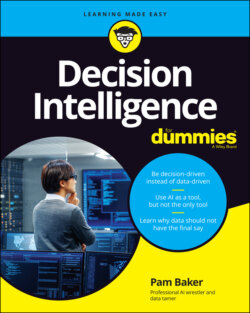Читать книгу Decision Intelligence For Dummies - Pamela Baker - Страница 53
All the helicopters are broken
ОглавлениеThe trouble with data sets is that no matter how large they are, something is always missing. That’s because there’s no singular, all-inclusive data singularity — no single data source containing all known information, in other words. There’s only a hodgepodge collection of data scattered here and there and yonder. By its nature, any of those data sets is incomplete.
The thing is, people analyze incomplete data anyway because good enough is always better than perfect, simply because perfect doesn’t exist. Even if there were a data singularity, data would most certainly still be missing from the pile. There appears to be no such thing as a true know-it-all in flesh or digital form.
That means data scientists and other data professionals must make assumptions, infer, augment, and otherwise tinker about to reach a reasonable output in the final analysis. There’s nothing wrong with that. Your own human mind works that way. For example, if your eyes didn’t catch all the details in a scene, your brain reaches back to your knowledge banks and memories to fill in the blanks so that you can better interpret what you saw. That method works well in helping you select an immediate escape action in an emergency, but it’s pretty much a total fail when it comes to the recollections of eyewitnesses in legal testimonies.
People can often see many places where data is incomplete and augment it accordingly, but the other ways in which data is incomplete often escape notice, because again, your own brain is filling in a picture for you of what should be there but often isn’t.
To hammer this point home, think of the problems associated with analyzing data in the hope of discovering what causes helicopter crashes. Data from helicopter crashes around the world and over time are carefully collected to be analyzed. So far, so good, right?! Yes — until the moment the machine informs you that all the helicopters are broken, which, of course, is untrue.
But the machine thinks it’s true because the only data it saw was from crashed helicopters. To accurately analyze why helicopters crash, the analytics and AI need to see data from helicopters that didn’t crash. In that data set will be helicopters that should have crashed but didn’t, and those that nearly did but shouldn’t have, as well as helicopters that functioned properly over numerous flights and in varied conditions. Now, there’s a better view of helicopter crashes and the machine finally learns that, no, helicopters don’t crash because all the helicopters are broken. It took a human to realize that fact first, however.
Decision intelligence adds more disciplines and methodologies to the decision-making process in order to move beyond (and guard against) faulty conclusions and misleading interpretations of outputs in order to move the organization forward to its desired outcome.
